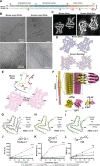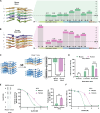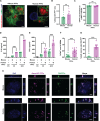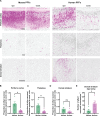Mouse α-synuclein fibrils are structurally and functionally distinct from human fibrils associated with Lewy body diseases
- PMID: 39485845
- PMCID: PMC11800946
- DOI: 10.1126/sciadv.adq3539
Mouse α-synuclein fibrils are structurally and functionally distinct from human fibrils associated with Lewy body diseases
Abstract
The intricate process of α-synuclein aggregation and fibrillization holds pivotal roles in Parkinson's disease (PD) and multiple system atrophy (MSA). While mouse α-synuclein can fibrillize in vitro, whether these fibrils commonly used in research to induce this process or form can reproduce structures in the human brain remains unknown. Here, we report the first atomic structure of mouse α-synuclein fibrils, which was solved in parallel by two independent teams. The structure shows striking similarity to MSA-amplified and PD-associated E46K fibrils. However, mouse α-synuclein fibrils display altered packing arrangements, reduced hydrophobicity, and heightened fragmentation sensitivity and evoke only weak immunological responses. Furthermore, mouse α-synuclein fibrils exhibit exacerbated pathological spread in neurons and humanized α-synuclein mice. These findings provide critical insights into the structural underpinnings of α-synuclein pathogenicity and emphasize a need to reassess the role of mouse α-synuclein fibrils in the development of related diagnostic probes and therapeutic interventions.
Figures







Similar articles
-
Brain-derived and in vitro-seeded alpha-synuclein fibrils exhibit distinct biophysical profiles.Elife. 2024 Nov 25;13:RP92775. doi: 10.7554/eLife.92775. Elife. 2024. PMID: 39584804 Free PMC article.
-
α-Synuclein: Experimental Pathology.Cold Spring Harb Perspect Med. 2016 Sep 1;6(9):a024273. doi: 10.1101/cshperspect.a024273. Cold Spring Harb Perspect Med. 2016. PMID: 27481772 Free PMC article. Review.
-
Overexpression of α-Synuclein by Oligodendrocytes in Transgenic Mice Does Not Recapitulate the Fibrillar Aggregation Seen in Multiple System Atrophy.Cells. 2020 Oct 29;9(11):2371. doi: 10.3390/cells9112371. Cells. 2020. PMID: 33138150 Free PMC article.
-
Structural heterogeneity of α-synuclein fibrils amplified from patient brain extracts.Nat Commun. 2019 Dec 4;10(1):5535. doi: 10.1038/s41467-019-13564-w. Nat Commun. 2019. PMID: 31797870 Free PMC article.
-
Alpha-synuclein structure and Parkinson's disease - lessons and emerging principles.Mol Neurodegener. 2019 Jul 22;14(1):29. doi: 10.1186/s13024-019-0329-1. Mol Neurodegener. 2019. PMID: 31331359 Free PMC article. Review.
Cited by
-
The effect of AKT inhibition in α-synuclein-dependent neurodegeneration.Front Mol Neurosci. 2025 Feb 5;18:1524044. doi: 10.3389/fnmol.2025.1524044. eCollection 2025. Front Mol Neurosci. 2025. PMID: 39974188 Free PMC article.
-
Lewy body diseases and the gut.Mol Neurodegener. 2025 Jan 30;20(1):14. doi: 10.1186/s13024-025-00804-5. Mol Neurodegener. 2025. PMID: 39885558 Free PMC article. Review.
-
Synaptic vesicle-omics in mice captures signatures of aging and synucleinopathy.Nat Commun. 2025 May 1;16(1):4079. doi: 10.1038/s41467-025-59441-7. Nat Commun. 2025. PMID: 40312501 Free PMC article.
-
Expression of human A53T alpha-synuclein without endogenous rat alpha-synuclein fails to elicit Parkinson's disease-related phenotypes in a novel humanized rat model.PLoS One. 2025 Aug 8;20(8):e0329823. doi: 10.1371/journal.pone.0329823. eCollection 2025. PLoS One. 2025. PMID: 40779487 Free PMC article.
-
Mechanisms of Alpha-Synuclein-Seeded Aggregation in Neurons Revealed by Fluorescence Lifetime Imaging.ACS Chem Neurosci. 2025 Jun 4;16(11):2128-2140. doi: 10.1021/acschemneuro.5c00236. Epub 2025 May 27. ACS Chem Neurosci. 2025. PMID: 40421805 Free PMC article.
References
-
- Pollanen M. S., Dickson D. W., Bergeron C., Pathology and biology of the Lewy body. J. Neuropathol. Exp. Neurol. 52, 183–191 (1993). - PubMed
-
- Spillantini M. G., Schmidt M. L., Lee V. M., Trojanowski J. Q., Jakes R., Goedert M., α-Synuclein in Lewy bodies. Nature 388, 839–840 (1997). - PubMed
-
- Schweighauser M., Shi Y., Tarutani A., Kametani F., Murzin A. G., Ghetti B., Matsubara T., Tomita T., Ando T., Hasegawa K., Murayama S., Yoshida M., Hasegawa M., Scheres S. H. W., Goedert M., Structures of α-synuclein filaments from multiple system atrophy. Nature 585, 464–469 (2020). - PMC - PubMed
-
- Yang Y., Shi Y., Schweighauser M., Zhang X., Kotecha A., Murzin A. G., Garringer H. J., Cullinane P. W., Saito Y., Foroud T., Warner T. T., Hasegawa K., Vidal R., Murayama S., Revesz T., Ghetti B., Hasegawa M., Lashley T., Scheres S. H. W., Goedert M., Structures of α-synuclein filaments from human brains with Lewy pathology. Nature 610, 791–795 (2022). - PMC - PubMed
-
- Yang Y., Garringer H. J., Shi Y., Lövestam S., Peak-Chew S., Zhang X., Kotecha A., Bacioglu M., Koto A., Takao M., Spillantini M. G., Ghetti B., Vidal R., Murzin A. G., Scheres S. H. W., Goedert M., New SNCA mutation and structures of α-synuclein filaments from juvenile-onset synucleinopathy. Acta Neuropathol. 145, 561–572 (2023). - PMC - PubMed
MeSH terms
Substances
Grants and funding
LinkOut - more resources
Full Text Sources
Medical

